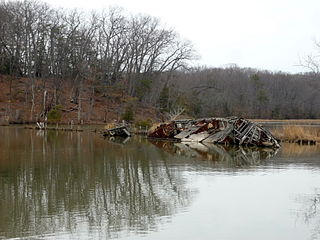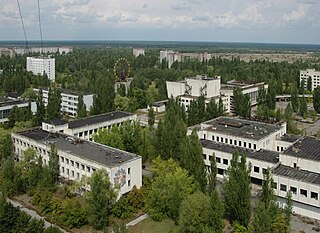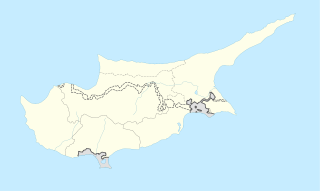 W
WModern ruins is a neologism referring to the ruins of architecture constructed in the recent past, generally in the most recent century, or since the 19th century. The term is most frequently used by people performing urban exploration of man-made architecture that is abandoned or no longer accessible to the general public, such as structures abandoned through the process of urban decay. Enough documentation on these sites may have been lost over time that this unscientific exploration resembles archaeology of ancient ruins in the methods used to collect information.
 W
WTkvarcheli is a town in Abkhazia. It is situated on the river Ghalidzga (Aaldzga) and a railroad connects it with Ochamchire. Akarmara, an area within the town, is a ghost town with abandoned apartments and factories which became uninhabited in the early 1990s due to the War in Abkhazia (1992-3).
 W
WAlddreu Airfield also known as Cheju-do No. 2 (K-40) Air Base was a former Imperial Japanese Navy Air Service and United States Air Force (USAF) air base on southern Jeju Island. It was mostly returned to farm land from the late 1960s onwards, though the site is still owned and used to some extent by the Republic of Korea Air Force, in particular a grass airstrip known semi-officially as Alddreu Airport.
 W
WThe Arthur de Buyer Coal Mine, or coal mine #11, was one of the major Ronchamp coal mines, which is in the area of the city Magny-Danigon in the French region of Franche-Comté. Digging started in 1894 to ensure the future of the company. The project was directed by Leon Poussigue, director of the company since 1891. He was responsible for organizing the excavation, designing buildings and installing each machine. The seat is named to tribute of Arthur de Buyer, the president since 1876. He retired during the commissioning activity of the mine.
 W
WAustralia Hall is a former entertainment hall in Pembroke, Malta, which was built by the Australian Branch of the British Red Cross Society in 1915. The building burnt down in 1998, and only its roofless shell remains today, the rebuilding of this site was cancelled.
 W
WBlub, short for Berliner Luft- und Badeparadies, was a water park in the Britz area of Neukölln district in Berlin, Germany. First opened in 1985, it was shut down in 2002 following health concerns, and the 3.5-hectare (8.6-acre) site fell into disrepair. In 2016, the buildings on the site were severely destroyed by fire. The site is planned to be redeveloped.
 W
WFort Campbell, also known locally as Il-Fortizza ta' Selmun, is a former fort in Mellieħa, Malta. It was built by the British between 1937 and 1938. It is notable as the most important fortification north of the Victoria Lines, and the last major fortification to be built in Malta. Today, it lies in ruins.
 W
WThe Haludovo Palace Hotel is an abandoned resort hotel on the Croatian island Krk north of Malinska. The hotel is named after a nearby beach.
 W
WHashima Island (端島), commonly called Gunkanjima, is an abandoned island of Nagasaki, lying about 15 kilometers (9 miles) from the center of the city. It is one of 505 uninhabited islands in Nagasaki Prefecture. The island's most notable features are its abandoned concrete buildings, undisturbed except by nature, and the surrounding sea wall. While the island is a symbol of the rapid industrialization of Japan, it is also a reminder of Japanese war crimes as a site of forced labour prior to and during the Second World War.
 W
WThe Iversky Monastery was a monastery of the Ukrainian Orthodox Church in Donetsk, Ukraine. It was built between 1997 and 2001, and was closed in 2014 due to the War in Donbass. The monastery was largely destroyed by Ukrainian Ground Forces shelling during the Second Battle of Donetsk Airport in January 2015.
 W
WThe Jerma Palace Hotel is a former four-star hotel in Marsaskala, Malta. It was opened in 1982, and was managed by Corinthia Hotels International. It was the largest hotel in southern Malta until it closed down in 2007. The building was subsequently abandoned, and it has since fallen into a state of disrepair. Plans to demolish the former hotel began in 2016.
 W
WWarner Bros. Jungle Habitat, which was in West Milford, in Passaic County, New Jersey, United States, was a Warner Bros.-owned theme park that opened in the summer of 1972, and closed in October 1976. By November 1972, the park had 500,000 paid visitors. The park contained over 1,500 animals; it consisted of a drive-through section and a walk-through section. The drive-through section was an animal safari park and the walk-through area was called Jungle Junction.
 W
WMallows Bay is a small bay on the Maryland side of the Potomac River in Charles County, Maryland, USA. The bay is the location of what is regarded as the "largest shipwreck fleet in the Western Hemisphere" and is described as a "ship graveyard."
 W
WMingulay is the second largest of the Bishop's Isles in the Outer Hebrides of Scotland. Located 12 miles (19 km) south of Barra, it is known for its important seabird populations, including puffins, black-legged kittiwakes, and razorbills, which nest in the sea-cliffs, amongst the highest in the British Isles.
 W
WThe National Capitol Columns is a monument in Washington, D.C.'s National Arboretum. It is an arrangement of twenty-two Corinthian columns which were a part of the United States Capitol from 1828 to 1958, placed amid 20 acres (8.1 ha) of open meadow, known as the Ellipse Meadow.
 W
WNishiki is a town located in Kuma District, Kumamoto Prefecture, Japan. The town's name is the Japanese word for "brocade", and is used as a name for more than one town in Japan. The town can trace its origin back to the merger of three villages in 1884. Two more villages were merged with Nishiki, then known as Nishi-mura or "West village", in 1955. It formally gained its status as a town on April 1, 1965. At one time, between 1985 and 2006, Nishiki was twinned with the town of Nishiki, Yamaguchi.
 W
WNorth and South Brother Islands are a pair of small islands located in New York City's East River between the mainland Bronx and Rikers Island. North Brother Island was once the site of a hospital, but is now uninhabited and designated as a bird sanctuary. It had long been privately owned, but it was purchased by the city in 2007.
 W
WThe Packard Automotive Plant is a former automobile-manufacturing factory in Detroit, Michigan, where luxury cars were made by the Packard Motor Car Company and later by the Studebaker-Packard Corporation.
 W
WPripyat or Prypiat is a ghost city in northern Ukraine, near the Ukraine–Belarus border. Named after the nearby river Pripyat, the city was founded on February 4, 1970, as the ninth nuclear city in the Soviet Union, to serve the nearby Chernobyl Nuclear Power Plant. It was officially proclaimed a city in 1979 and had grown to a population of 49,360 by the time it was evacuated on the afternoon of 27 April 1986, the day after the Chernobyl disaster.
 W
WThe South Beach Branch, also called the East Shore Sub-Division, is an abandoned branch of the Staten Island Railway in New York City, which operated along Staten Island's East Shore from Clifton to Wentworth Avenue. This 4.1-mile (6.6 km) double-tracked branch left the Main Line at 40°37′08″N 74°04′18″W, south of the Clifton station, and lay to the east of the Main Line.
 W
WRuins photography, sometimes called ruin porn, is a recent movement in photography that takes the decline of the built environment as its subject. While "ruins" may be broadly defined as the remnants of human achievement, "ruins photography" refers specifically to the capture of urban decay in the post-industrial areas of the world. Ruins photography catalogues the abandonment and decline of cities most of all, and has sparked conversations about the role of art in various urban renewal, restoration, and conservation projects in cities throughout the globe.
 W
WSt. Peter's Seminary is a former Roman Catholic seminary near Cardross, Argyll and Bute, Scotland. Designed by the firm of Gillespie, Kidd & Coia, it has been described by the international architecture conservation organisation DOCOMOMO as a modern "building of world significance". It is one of only 42 post-war buildings in Scotland to be listed at Category A, the highest level of protection for a building of "special architectural or historic interest". It has been abandoned since 1987, and is currently in a ruinous state. In July 2020, the site was bequeathed to the Kilmahew Education Trust Ltd who plan to reinstate the educational elements of the Seminary Complex after a process of conservation and restoration. The wider Kilmahew Estate is to be brought back to its former glory with new landscaping and features but is currently closed to the public due to safety concerns.
 W
WThe Vallée des Rouets is a part of the valley of the Durolle river, principally situated on the land of Thiers, in the French department of Puy-de-Dôme in the Auvergne-Rhône-Alpes region. The area is known for its long artisanal past, as the inhabitants have made use of the locomotive power of the Durolle River since the Middle Ages. The beginning of the 20th century marked the closure of most of the water-powered mills in the valley in favor of the production of cutlery, mainly situated in the Vallée des Usines, located downstream.
 W
WVarosha is an abandoned southern quarter of the Cypriot city of Famagusta. Before 1974, it was the modern tourist area of the city. Its inhabitants fled during the Turkish invasion of Cyprus in 1974, when the city of Famagusta came under Turkish control, and it has remained abandoned ever since. As of 2019, the quarter continues to be uninhabited; buildings have decayed, and, in some cases, their contents have been looted over the years; some streets have been overgrown with vegetation; and the quarter is generally described as a ghost town. Entry is forbidden to the public.
 W
WVilla Epecuén was a tourist village in Buenos Aires Province, Argentina, on the eastern shore of Laguna Epecuén, about 7 kilometres (4.3 mi) north of the city of Carhué. Developed in the early 1920s, Epecuén was accessible from Buenos Aires by train. The Sarmiento Railway line served Villa Epecuén station, while the Midland Railway and the Buenos Aires Great Southern Railway carried passengers to nearby Carhué station. Tourism was developed by an Englishman after taking the land on lease. He marketed the lake as having healing properties, hiring Italian scientists to bolster the claim. At its height, Villa Epecuén could accommodate at least 5,000 visitors.
 W
WWestchester Avenue is a former railroad station located in the borough of the Bronx in New York City, partially suspended over Amtrak's busy Northeast Corridor line. It was built in 1908 with rich terra cotta detailing to a design by Cass Gilbert, who would later employ similar terra cotta detailing in his 1910 design for the Woolworth Building. Train service to the station ceased in 1937, and as of 2014 the station was a ruin in poor condition.